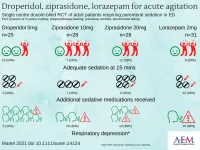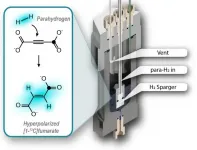(Press-News.org) Isaac Newton may have met his match.
For centuries, engineers have relied on physical laws -- developed by Newton and others -- to understand the stresses and strains on the materials they work with. But solving those equations can be a computational slog, especially for complex materials.
MIT researchers have developed a technique to quickly determine certain properties of a material, like stress and strain, based on an image of the material showing its internal structure. The approach could one day eliminate the need for arduous physics-based calculations, instead relying on computer vision and machine learning to generate estimates in real time.
The researchers say the advance could enable faster design prototyping and material inspections. "It's a brand new approach," says Zhenze Yang, adding that the algorithm "completes the whole process without any domain knowledge of physics."
The research appears today in the journal Science Advances. Yang is the paper's lead author and a PhD student in the Department of Materials Science and Engineering. Co-authors include former MIT postdoc Chi-Hua Yu and Markus Buehler, the McAfee Professor of Engineering and the director of the Laboratory for Atomistic and Molecular Mechanics.
Engineers spend lots of time solving equations. They help reveal a material's internal forces, like stress and strain, which can cause that material to deform or break. Such calculations might suggest how a proposed bridge would hold up amid heavy traffic loads or high winds. Unlike Sir Isaac, engineers today don't need pen and paper for the task. "Many generations of mathematicians and engineers have written down these equations and then figured out how to solve them on computers," says Buehler. "But it's still a tough problem. It's very expensive -- it can take days, weeks, or even months to run some simulations. So, we thought: Let's teach an AI to do this problem for you."
The researchers turned to a machine learning technique called a Generative Adversarial Neural Network. They trained the network with thousands of paired images -- one depicting a material's internal microstructure subject to mechanical forces, and the other depicting that same material's color-coded stress and strain values. With these examples, the network uses principles of game theory to iteratively figure out the relationships between the geometry of a material and its resulting stresses.
"So, from a picture, the computer is able to predict all those forces: the deformations, the stresses, and so forth," Buehler says. "That's really the breakthrough -- in the conventional way, you would need to code the equations and ask the computer to solve partial differential equations. We just go picture to picture."
That image-based approach is especially advantageous for complex, composite materials. Forces on a material may operate differently at the atomic scale than at the macroscopic scale. "If you look at an airplane, you might have glue, a metal, and a polymer in between. So, you have all these different faces and different scales that determine the solution," say Buehler. "If you go the hard way -- the Newton way -- you have to walk a huge detour to get to the answer."
But the researcher's network is adept at dealing with multiple scales. It processes information through a series of "convolutions," which analyze the images at progressively larger scales. "That's why these neural networks are a great fit for describing material properties," says Buehler.
The fully trained network performed well in tests, successfully rendering stress and strain values given a series of close-up images of the microstructure of various soft composite materials. The network was even able to capture "singularities," like cracks developing in a material. In these instances, forces and fields change rapidly across tiny distances. "As a material scientist, you would want to know if the model can recreate those singularities," says Buehler. "And the answer is yes."
The advance could "significantly reduce the iterations needed to design products," according to Suvranu De, a mechanical engineer at Rensselaer Polytechnic Institute who was not involved in the research. "The end-to-end approach proposed in this paper will have a significant impact on a variety of engineering applications -- from composites used in the automotive and aircraft industries to natural and engineered biomaterials. It will also have significant applications in the realm of pure scientific inquiry, as force plays a critical role in a surprisingly wide range of applications from micro/nanoelectronics to the migration and differentiation of cells."
In addition to saving engineers time and money, the new technique could give nonexperts access to state-of-the-art materials calculations. Architects or product designers, for example, could test the viability of their ideas before passing the project along to an engineering team. "They can just draw their proposal and find out," says Buehler. "That's a big deal."
Once trained, the network runs almost instantaneously on consumer-grade computer processors. That could enable mechanics and inspectors to diagnose potential problems with machinery simply by taking a picture.
In the new paper, the researchers worked primarily with composite materials that included both soft and brittle components in a variety of random geometrical arrangements. In future work, the team plans to use a wider range of material types. "I really think this method is going to have a huge impact," says Buehler. "Empowering engineers with AI is really what we're trying to do here."
INFORMATION:
Funding for this research was provided, in part, by the Army Research Office and the Office of Naval Research.
Des Plaines, IL - In a randomized, double-blind trial of patients with acute undifferentiated agitation in the emergency department, droperidol was more effective for sedation and was associated with fewer episodes of respiratory depression than lorazepam or either dose of ziprasidone. This is the conclusion of END ...
COLUMBIA, Mo. -- Having grown up poor in a rural village in Zimbabwe, Wilson Majee saw firsthand as a child the lack of educational opportunities that were easily accessible and how that impacted the youth in his village.
Now an associate professor in the University of Missouri School of Health Professions, Majee researches the challenges facing disadvantaged, rural youth. He found in a recent study that young people who are disengaged from their communities are much more likely to participate in risky behaviors such as substance abuse, particularly in rural areas that lack educational opportunities.
For the study, Majee spoke with youth in rural South Africa about the factors contributing to drug abuse for the NEET population, which stands ...
A promising new concept published by an interdisciplinary research team in "Proceedings of the National Academy of Sciences" (PNAS) paves the way for major advances in the field of magnetic resonance imaging (MRI). Their new technique could significantly simplify hyperpolarized MRI, which developed around 20 years ago for observing metabolic processes in the body. The proposal involves the hyperpolarization of the metabolic product fumarate using parahydrogen and the subsequent purification of the metabolite. "This technique would not only be simpler, but also much cheaper than the previous procedure," said leader of the project Dr. James Eills, a member of the research team of Professor Dmitry Budker at Johannes Gutenberg ...
African waters have been contributing to the global supply of fish for years, with three of the four most productive marine ecosystems in the world near the continent. African countries' Exclusive Economic Zones (EEZs) contributed over 6 million metric tons of fish to the world's food supply, supporting food security and livelihood in the continent, while generating $15 billion to the African gross domestic product in 2011. Every sovereign state has an EEZ, an area of ocean adjacent to their shores in which they have special rights regarding the exploration and use of marine resources.
Industrial fleets from countries around the world have been increasingly fishing in African waters, but with climate change ...
The risk of developing atherosclerosis - a narrowing of the arteries as cholesterol plaque builds up, leading to obstruction of blood flow - is higher for people with autoimmune rheumatic diseases than for the general population. As a result, they are more likely to have heart attacks and other cardiovascular disorders.
The good news, according to a new study published in Rheumatology, is that regular exercise is a powerful weapon against vascular dysfunction in these patients.
In the article, researchers working in Brazil and the United Kingdom report the results of a systematic review of the scientific literature on the subject. The review, which ...
SAN FRANCISCO, CA--April 27, 2021--In the 40-some years since the beginning of the HIV/AIDS epidemic, scientists have learned a lot about the virus, the disease, and ways to treat it. But one thing they still don't completely understand is which exact cells are most susceptible to HIV infection.
Without this knowledge, it is difficult to envision targeting these cells to protect the millions of people who encounter the virus for the first time every year, or the infected people in which infection will likely rebound if they go off therapy.
Scientists have known for a long time that the virus homes in on so-called memory ...
Researchers have spent more than three decades developing and studying miniature biosensors that can identify single molecules. In five to 10 years, when such devices may become a staple in doctors' offices, they could detect molecular markers for cancer and other diseases and assess the effectiveness of drug treatment to fight those illnesses.
To help make that happen and to boost the accuracy and speed of these measurements, scientists must find ways to better understand how molecules interact with these sensors. Researchers from the National Institute of Standards and Technology (NIST) and Virginia Commonwealth University (VCU) have now developed a new approach. ...
Skoltech researchers used Google Trends' Big Data ensuing from human interactions with the Internet to develop a new methodology - a tool and a data source - for analyzing and researching the growth of startups. A paper reporting these important findings was published in technology management journal, Technological Forecasting and Social Change.
Startups and high-growth technology-based ventures they transform into are regarded as the key drivers of economic development, innovation, and job creation on the national and global level. However, despite their crucial importance for the economy and high interest from researchers and policy-makers, startups display growth patterns that are difficult to analyze. These fragile, early-stage private ...
New research from the University of Surrey has shown that silicon could be one of the most powerful materials for photonic informational manipulation - opening up new possibilities for the production of lasers and displays.
While computer chips' extraordinary success has confirmed silicon as the prime material for electronic information control, silicon has a reputation as a poor choice for photonics; there are no commercially available silicon light-emitting diodes, lasers or displays.
Now, in a paper published by Light: Science and Applications journal, a Surrey-led international team of scientists has ...
A pregnant woman's exposure to tobacco smoke and pollution from road traffic can influence the development of behavioural outcomes in early childhood. This is the conclusion of a recent study led by a team from the Barcelona Institute for Global Health (ISGlobal), a centre supported by the "la Caixa" Foundation. The study, published in Environmental International, is the first to investigate the impact of the exposome--i.e. the set of all environmental exposures, both chemical and non-chemical, during the prenatal and postnatal stages--on child behaviour. Previous research had assessed the impact of environmental ...







